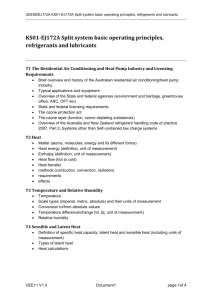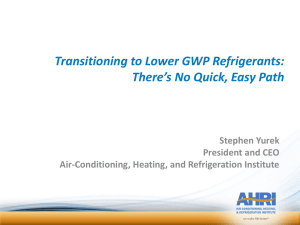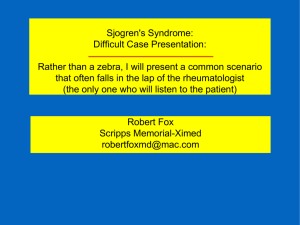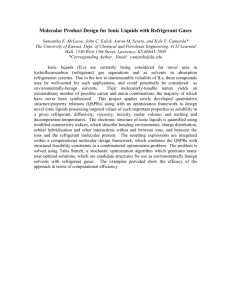How to protect all acr systems when using the
advertisement
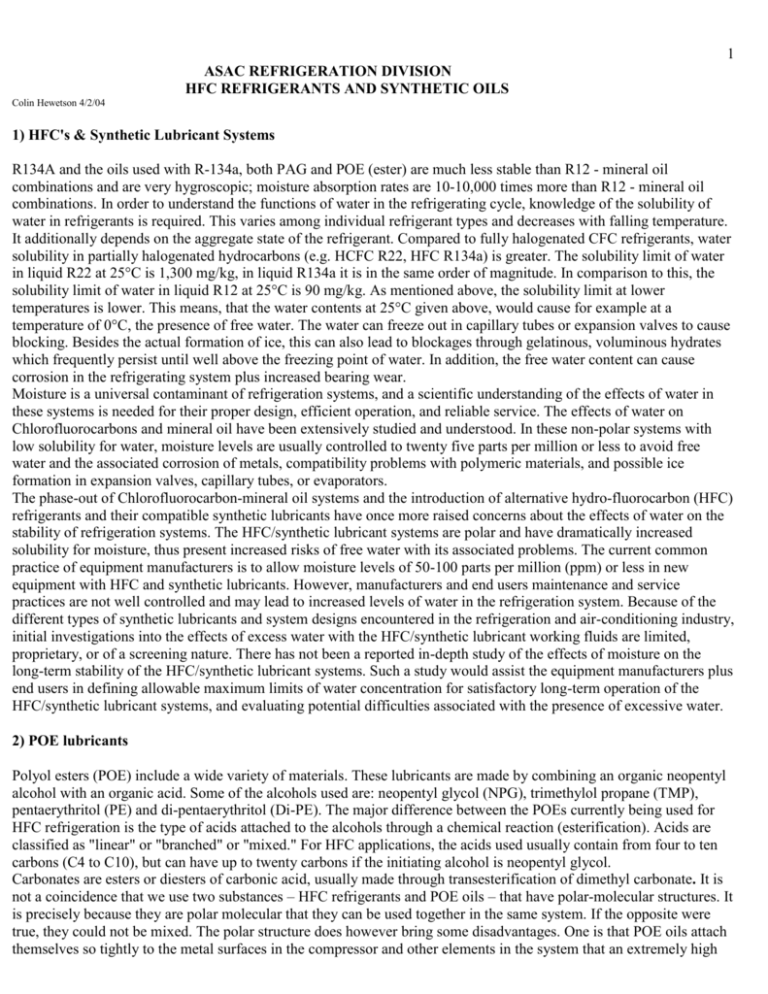
1 ASAC REFRIGERATION DIVISION HFC REFRIGERANTS AND SYNTHETIC OILS Colin Hewetson 4/2/04 1) HFC's & Synthetic Lubricant Systems R134A and the oils used with R-134a, both PAG and POE (ester) are much less stable than R12 - mineral oil combinations and are very hygroscopic; moisture absorption rates are 10-10,000 times more than R12 - mineral oil combinations. In order to understand the functions of water in the refrigerating cycle, knowledge of the solubility of water in refrigerants is required. This varies among individual refrigerant types and decreases with falling temperature. It additionally depends on the aggregate state of the refrigerant. Compared to fully halogenated CFC refrigerants, water solubility in partially halogenated hydrocarbons (e.g. HCFC R22, HFC R134a) is greater. The solubility limit of water in liquid R22 at 25°C is 1,300 mg/kg, in liquid R134a it is in the same order of magnitude. In comparison to this, the solubility limit of water in liquid R12 at 25°C is 90 mg/kg. As mentioned above, the solubility limit at lower temperatures is lower. This means, that the water contents at 25°C given above, would cause for example at a temperature of 0°C, the presence of free water. The water can freeze out in capillary tubes or expansion valves to cause blocking. Besides the actual formation of ice, this can also lead to blockages through gelatinous, voluminous hydrates which frequently persist until well above the freezing point of water. In addition, the free water content can cause corrosion in the refrigerating system plus increased bearing wear. Moisture is a universal contaminant of refrigeration systems, and a scientific understanding of the effects of water in these systems is needed for their proper design, efficient operation, and reliable service. The effects of water on Chlorofluorocarbons and mineral oil have been extensively studied and understood. In these non-polar systems with low solubility for water, moisture levels are usually controlled to twenty five parts per million or less to avoid free water and the associated corrosion of metals, compatibility problems with polymeric materials, and possible ice formation in expansion valves, capillary tubes, or evaporators. The phase-out of Chlorofluorocarbon-mineral oil systems and the introduction of alternative hydro-fluorocarbon (HFC) refrigerants and their compatible synthetic lubricants have once more raised concerns about the effects of water on the stability of refrigeration systems. The HFC/synthetic lubricant systems are polar and have dramatically increased solubility for moisture, thus present increased risks of free water with its associated problems. The current common practice of equipment manufacturers is to allow moisture levels of 50-100 parts per million (ppm) or less in new equipment with HFC and synthetic lubricants. However, manufacturers and end users maintenance and service practices are not well controlled and may lead to increased levels of water in the refrigeration system. Because of the different types of synthetic lubricants and system designs encountered in the refrigeration and air-conditioning industry, initial investigations into the effects of excess water with the HFC/synthetic lubricant working fluids are limited, proprietary, or of a screening nature. There has not been a reported in-depth study of the effects of moisture on the long-term stability of the HFC/synthetic lubricant systems. Such a study would assist the equipment manufacturers plus end users in defining allowable maximum limits of water concentration for satisfactory long-term operation of the HFC/synthetic lubricant systems, and evaluating potential difficulties associated with the presence of excessive water. 2) POE lubricants Polyol esters (POE) include a wide variety of materials. These lubricants are made by combining an organic neopentyl alcohol with an organic acid. Some of the alcohols used are: neopentyl glycol (NPG), trimethylol propane (TMP), pentaerythritol (PE) and di-pentaerythritol (Di-PE). The major difference between the POEs currently being used for HFC refrigeration is the type of acids attached to the alcohols through a chemical reaction (esterification). Acids are classified as "linear" or "branched" or "mixed." For HFC applications, the acids used usually contain from four to ten carbons (C4 to C10), but can have up to twenty carbons if the initiating alcohol is neopentyl glycol. Carbonates are esters or diesters of carbonic acid, usually made through transesterification of dimethyl carbonate. It is not a coincidence that we use two substances – HFC refrigerants and POE oils – that have polar-molecular structures. It is precisely because they are polar molecular that they can be used together in the same system. If the opposite were true, they could not be mixed. The polar structure does however bring some disadvantages. One is that POE oils attach themselves so tightly to the metal surfaces in the compressor and other elements in the system that an extremely high 2 degree of system hygiene is necessary. This can be a particular problem when changing over from CFC or HCFC to the new media because old deposits and oxides can become loose and begin circulating freely as system contaminants. With POE oils a high moisture level above 75ppm will start hydrolysis in which the oil is converted into carboxylic acid or its constituent formulation products of acids & acholol. To prevent such acid formation, proper system filter driers must be installed and system hygiene and evacuation techniques followed, oil stocks should be sampled and analysed for moisture content prior to use. POE oils are made by a reaction between Ester Acids and Alcohol, where the by-product is POE lubricant and water. If the water levels are reintroduced to levels above 75 PPM a resulting chemical reaction between the water and oil or between the water/oil and HFC refrigerant may arise and the POE may revert to its component parts and create acids and a small amount of alcohol. Such reaction may take place with or without a heat source. Keeping this in mind, the moisture and acids must be removed as soon as possible to prevent the possibility of system damage. The effects of such chemical reactions are Clathrate hydrates, first discovered in 1810, are solid solutions formed when water molecules are linked through hydrogen bonding creating cavities that can enclose various guest molecules also known as hydrate formers. Hydrolysis, chemical reaction of a compound with water, usually resulting in the formation of one or more new compounds such as Carbolyxic or Hydroflouric or fatty acids, base glycols or Alcohol. Polyolester (POE) lubricants hydrolyze in the presence of water while polyvinylethers (PVE) do not. Hydrolysis activity of POE is more frequently acid catalyzed than base-catalyzed and tends to increase with high water content and high residual carboxylic acids. The hydrolysis reaction rate constants typically show temperature dependence consistent with an activated process following the Arrhenius equation. Hydrolytic stability of POE in tests were shown to improve with hindered POE , and with the presence of acid catcher additives and molecular sieve desiccant. 3) Other reactions In general, under lubricated conditions, water vapor can modify the adsorption of long-chain fatty acids that act as boundary lubricants, thus influencing friction and wear. Water can also affect the chemistry of protective film formation by oxygen. However, depending on the lubricants tested and the conditions of the tests, the effects can be either positive or negative. A positive effect corresponds to a decrease in wear with increasing water content while a negative effect corresponds to an increase in wear with increasing water content. The presence of moisture was observed to cause the embrittlement of polyethylene terephthalate and the hydrolysis of polyester materials. On the positive side, water was shown to reduce the effect of amine additives on fluoroelastomer rubbers. The reactions of water with refrigerants or the hydrolysis of organic solvents and lubricants have been shown to cause formicary and large-pit corrosion in copper tubes, as well as copper plating and sludge formation in refrigeration systems. Moreover, studies of blockage of capillary tubes showed that blockage is low in dry systems, but increases rapidly in the presence of water or when the system is doped with carboxylic acid. Among the problems that would most likely result from the presence of high moisture level in the refrigeration systems, lubricant breakdown is of greatest concern, followed by acid formation, compressor failure and expansion valve sticking. Elastomeric seal failure and sticking of suction valve cause fewer concerns. With few exceptions, the chemical and physical stability of lubricants are threatened by even the slightest amount of suspended water. As previously indicated water can promote a host of chemical reactions (hydrolysis) with compounds and atomic species including oil additives, base stock and suspended contaminants. In combination with oxygen, heat, and metal catalysts, water is known to promote the oxidation and the formation of free radicals and peroxide compounds. Oxidation inhibitors are sacrificed by both neutralizing peroxides and breaking oxidation chain reactions to form stable compounds. Other oxidation inhibitors are known to form hydrogen sulfide and sulfonic acids when reacting with water. Experiments have shown the protection provided by zinc dialkyldithiophosphate (ZDDP), a common antiwear additive and antioxidant, to be destroyed by as little as one drop of water in a gallon of oil, with oil temperature above 180 degrees F(82 degrees C). 3 Water is also known to attack rust inhibitors, viscosity improvers, and the oil's base stock. The effects are undesirable by-products such as varnish, sludge, organic and inorganic acids, surface deposits and lubricant thickening (polymerization). Large amounts of emulsified water can lower viscosity, thereby reducing a lubricant's load carrying ability. When water is combined with metal catalysts such as iron or copper, accelerated stressing of the oil can occur. This results in base stock oxidation and the forming of free radicals (which continue the oxidation process), hydroperoxides, and acids. Some materials, which can be present as contaminants in hermetic systems, have been known to cause the breakdown of the refrigerants or lubricants resulting in the formation of elevated acid levels. Beside the typical contaminants of air and water, trace amounts of chemicals that are used as cleaning or processing materials may cause decomposition of the refrigerant or lubricant. Some chemicals may be reactive in themselves, while other chemicals such as brazing fluxes, rust inhibitors or additives may activate a metal surface increasing reactivity. The resulting contaminants may have limited solubility/miscibility characteristics, resulting in the formation of detrimental residues. 4) Filter driers and moisture indicating sight glasses The inclusion of proper filter driers is essential for POE/HFC systems. Filter-driers in the typical air-conditioning or refrigeration system are designed to perform several functions 1) as their name implies, is to filter out contaminants effectively, 2) to dry the refrigerant to avoid ice particle formation and oil degradation, 3) to remove acids formed as a product of moisture, oil and heat. Until recent years it has been easy to apply filter driers by the capacity of the filterdrier to handle the amount of refrigerant in the system without exerting an undue amount of pressure drop. Filter-driers perform their duty with the use of three different materials. Molecular sieve, which is just that, a sieve comprised of a material that has pores of the appropriate size and consistency to trap the water molecule flowing with the refrigerant oil. Activated Alumina, which has slightly larger pores of the proper size and shape to trap acid molecules. Activated Charcoal, which has the characteristic of removing paraffin or wax. Filter driers must be installed in the liquid charging line liquid line from condenser to evaporator, or if this is not feasible in a permanent recirculation system across the evaporator using an eductor or liquid refrigerant circulating pump. The driers need to be changed regularly in accordance to the moisture indicating sight glass indication or oil/refrigerant sample analysis of moisture presence. This may require filter changes daily/weekly/monthly until the moisture levels are below the point at which oil breakdown can occur e.g. < 75ppm There are 3 types of drier Loose fill driers are just as the name states, loosely filled with molecular sieve material which is held in the shell with mesh screens at either end. Commonly these driers are made of copper and are designed for use in domestic refrigerators and do not offer much in the way of filtration. Molded core filter-driers are a mix of the molecular sieve material, activated alumina and sometimes charcoal which is mixed with a binder, poured into a mould and baked. These filter-driers use the blended core as the filter bed and do not require a separate filter to accomplish 40 micron filtration levels. Since the outside of the core is used as the filter bed there is a possibility that the trapped particles can be washed through the core and proceed downstream to the rest of the system. It is therefore necessary to have a filter-drier with additional filtration capacity to remove the fine particles in both new and retrofit applications. Molded core filter-driers are bound by the porousness of the core to 40 microns and have a limited capacity to trap and hold solid contaminants. Finally, there are acidic additives to the POE that the oil manufacturers find necessary to increase lubricity and miscibility that should not be removed by the filter drier. Compacted bead filter-driers are a blend of beads of molecular sieve material and activated alumina which is held in place between two fiberglass pads which are compressed by a steel spring to prevent attrition through turbulence. Filtration is accomplished by the installation of a thick fiberglass pad at the inlet which has a 40 micron filtration rate. This pad holds more particulate at a lower pressure drop than the molded core and holds it from passing downstream to the desiccant bed and the system beyond. Of the three styles of filter-driers, moulded core and compacted bead offer the best of all three functions necessary for a good filter-drier. Of the two the compacted bead style can be formulated to meet any system or refrigerant-oil requirement without sacrificing the integrity of the desiccant bed. 4 Moisture liquid indicators Not all moisture-liquid indicators are alike. Their purpose is two-fold, to get a visual indication of the state of the refrigerant at that point in the system, and to indicate if the refrigerant is dry. Generally there are two different styles of moisture liquid indicators: 1) A yellow-to-green indicator 2) A red-to-blue four step indicator. The yellow-to-green indicator should be used primarily for mineral oil systems where oil breakdown is not as big a problem as with POE's. The reason is that the yellow-to-green change occurs at 150 ppm water at 125o with R-134a. This indication level is 75 ppm above the threshold at which POEs may break down and form system-harming acids. The red-to-blue indicator in AMI moisture liquid indicators gives a more accurate indication of moisture levels with all refrigerants: 1st level 190 ppm 2nd level 150 ppm 3rd level 85 ppm 4th level 60 ppm (based on R-134a and POE at 125o liquid temperature). When the indicator changes from the third level to the fourth level, you can be reasonably assured that the system is well below the breakdown point of the oil. 5) Summary for all R134A applications Evacuate refrigeration system in accordance to procedures; 5mmhg should be achieved and held for 24hrs without rise to ensure all water has migrated and then pulled down to 2mmhg and held for 24hrs. Where systems have been subject to free water entry due a tube leak or contaminated refrigerant/oil, (e.g. Marjan GOSP) it is not generally possible to heat the system in order to quickly dry it or increase the water vapour pressure above its freeze point. Additionally at below 5mmhg any water in the system will freeze and will remain in the system. As the water vapour removed during evacuation will be trapped in the vacuum pump oil and the water vapour partial pressure in the pump will approach the system water vapour pressure, further moisture removal is impossible. Therefore a cold trap should be installed in the evacuation line to remove the water whereby the vapour condenses or freezes on the cold trap and not in the system plus the pump oil does not become water saturated. Fit filter driers to charge point, liquid line and if necessary install a filter drier system across the evaporator and continuously circulate refrigerant using an eductor or refrigerant pump. Analyse all synthetic oil & refrigerant prior to use for acid and moisture content and ensure suppliers quality control certificates are available for the oil and Refrigerant. Install 4 step liquid moisture indicating sight glass in the liquid line. Change filter drier cores on a regular basis. Obtain system oil and refrigerant sample analysis for moisture and acid content on a regular basis, at least quarterly. As part of annual T & I pressure leak test water cooled condensers and S&T evaporators to ensure no tube leaks. Undertake weekly refrigerant leak test of complete refrigerant system. REFERENCES Fitch, E. C., Fluid Contamination Control. Stillwater: FES, Inc., 1988. Fitch, J. C., "Contaminant Monitoring Targets Root Causes of Machinery Problems," P/PM Technology Magazine. Volume 4, Issue 2, March/April, 1991. Fitch, J. C., Oil Analysis and Proactive Maintenance - A Complete Users Guide For Maintenance Professionals. Diagnetics, Inc., 1994, 1994-4 Edition. Wooding, P. S., W. R. Murphy, S. J. Leonardi, E. L. Armstrong "Evaluation of Water-Accelerated Bearing Fatigue in OilLubricated Ball Bearings," Lubrication Engineering. Volume 34, 1, 15-21 January, 1978. Zaretsky, Erwin V., Editor. STLE Life Factors for Rolling Bearings. Society of Tribologists and Engineers, 1992. Alco driers Dean & Wood 5 Spauchus Assoc Inc CPI engineering services Solvay refrigerants


